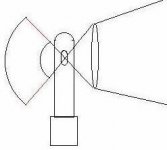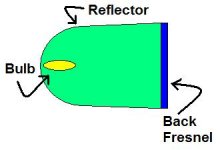Why is it that lumenlab does not have condenser lenses and reflectors, cold mirror on their site. For that matter neither does diyprojectorcompany.com.
Where can I find these items?
Where can I find these items?
not needed
With large format projectors, a pre-condensor lens does not get you much more light. It might even lose more than it gathers!
Both of the websites you mentioned are oriented to 15" projectors, so they don't bother with pre-condensors. I think at least one of them does have a reflector. But a pretty good reflector is DIY made from an IKEA napkin holder. Others are DIY made from soup ladles or mixing bowls.
If you are building a small-format projector, then a pre-condensor lens will get you a lot more light into the LCD. Stores that focus on small format projectors (ie. exclusiv) do sell these lenses.
You can also check on edmunds optics online for expensive reflectors and lenses.
With large format projectors, a pre-condensor lens does not get you much more light. It might even lose more than it gathers!
Both of the websites you mentioned are oriented to 15" projectors, so they don't bother with pre-condensors. I think at least one of them does have a reflector. But a pretty good reflector is DIY made from an IKEA napkin holder. Others are DIY made from soup ladles or mixing bowls.
If you are building a small-format projector, then a pre-condensor lens will get you a lot more light into the LCD. Stores that focus on small format projectors (ie. exclusiv) do sell these lenses.
You can also check on edmunds optics online for expensive reflectors and lenses.
So you are saying if bulding a 15 inch lcd projector dont bother with reflector and condenser or just dont use a condenser?
My understanding was condensers go with reflector and you there is no real point in using one but not the other.
My understanding was condensers go with reflector and you there is no real point in using one but not the other.
pre-condensor lens & reflector
If you look at the angle the light travels from a lamp arc to a 15" or 17" diagonal 220 mm fl fresnel, you will see that it captures quite a bit of light. If you find the perfect pre-condensor lens for that fresnel, then you might capture 20% more light. But sending the light through the lens will lose about 10%. So you spend a lot of money and effort to get just a little bit more light.
If you use a 330 mm fl fresnel without a pre-condensor lens, then it will capture less light because it will be further from the lamp arc. Adding a pre-condensor lens will help a lot.
If you are building a small-format projector (ie. 7" Lilliput or 8" Hami), then a pre-condensor lens will make your fresnel capture MUCH more light: It may make your image four times brighter!
If your lamp does not include a reflector as part of the glass envelope, then you should ALWAYS add one. A simple polished metal spherical reflector is okay. An optical dichroic glass spherical reflector is better. ("dichroic" means it lets IR through the glass, but reflects visible light.) An elliptical reflector can be even better, but it takes some careful matching to the first fresnel.
I use a silver-plated hemispherical quiche mold, and it increases my image brightness by 22%.
If you use a pre-condensor lens, then the reflector should be wide enough to send light to the edges of the lens. Here is a picture with two different sizes of reflector. Either one will work, but you can see that both send light to the edges of the pre-condensor lens.
If you look at the angle the light travels from a lamp arc to a 15" or 17" diagonal 220 mm fl fresnel, you will see that it captures quite a bit of light. If you find the perfect pre-condensor lens for that fresnel, then you might capture 20% more light. But sending the light through the lens will lose about 10%. So you spend a lot of money and effort to get just a little bit more light.
If you use a 330 mm fl fresnel without a pre-condensor lens, then it will capture less light because it will be further from the lamp arc. Adding a pre-condensor lens will help a lot.
If you are building a small-format projector (ie. 7" Lilliput or 8" Hami), then a pre-condensor lens will make your fresnel capture MUCH more light: It may make your image four times brighter!
If your lamp does not include a reflector as part of the glass envelope, then you should ALWAYS add one. A simple polished metal spherical reflector is okay. An optical dichroic glass spherical reflector is better. ("dichroic" means it lets IR through the glass, but reflects visible light.) An elliptical reflector can be even better, but it takes some careful matching to the first fresnel.
I use a silver-plated hemispherical quiche mold, and it increases my image brightness by 22%.
If you use a pre-condensor lens, then the reflector should be wide enough to send light to the edges of the lens. Here is a picture with two different sizes of reflector. Either one will work, but you can see that both send light to the edges of the pre-condensor lens.
Attachments
I have a question about reflectors. Why not build a reflector that is spherical in the back (or elliptical) and then the reflector continues all the way to the back fresnel?
There would be heating issues I figured. But this would cause most of the light to go to the fresnel, wouldn't it? Maybe leave a little space between the fresnel and the end of the reflector hood for air to get in and then have a hole in the back to suck air past the bulb.
There would be heating issues I figured. But this would cause most of the light to go to the fresnel, wouldn't it? Maybe leave a little space between the fresnel and the end of the reflector hood for air to get in and then have a hole in the back to suck air past the bulb.
Attachments
Because "most of the light go to the fresnel" is not what we're looking for. We are trying to get a point light source and have all rays go from that source through the fresnel and then to the projection lens. It's not enough to have the rays bouncing at crazy angles before they reach the LCD. The image would be worse than a plain bulb with no reflector at all, because the contrast would be bad and there would be blurring and possibly multiple images.
got to send it through the lens
The idea is to get most of that light through the lens and onto the screen. A point source with a condensor fresnel to make a parallel beam the size of the LCD, and another fresnel to focus that into the projection lens is one way to do that.
But there are other ways that work. The method closest to "big reflector all the way to the LCD", is a custom parabolic reflector making a big parallel beam that gets focussed into the projection lens by a field fresnel. If you have the right curve and the lamp arc in the right position, then that would work pretty well with just one slight problem: You might see a bright spot in the middle of the screen from the direct light. One solution is to add a tiny spherical reflector right up against the front of the lamp arc. That would send all of the direct light back through the arc and to the parabolic reflector.
The idea is to get most of that light through the lens and onto the screen. A point source with a condensor fresnel to make a parallel beam the size of the LCD, and another fresnel to focus that into the projection lens is one way to do that.
But there are other ways that work. The method closest to "big reflector all the way to the LCD", is a custom parabolic reflector making a big parallel beam that gets focussed into the projection lens by a field fresnel. If you have the right curve and the lamp arc in the right position, then that would work pretty well with just one slight problem: You might see a bright spot in the middle of the screen from the direct light. One solution is to add a tiny spherical reflector right up against the front of the lamp arc. That would send all of the direct light back through the arc and to the parabolic reflector.
Ok, understand about the light going in all directions. I've seen the reflector/condenser lens setup. What about making a reflector with the condenser lens fitted to the reflector (bulb inside of course).
This is similar to a spotlight or a flashlight as I recall. Would this result in the same problems as before? I'm just trying to optimize as much light as possible.
An externally hosted image should be here but it was not working when we last tested it.
This is similar to a spotlight or a flashlight as I recall. Would this result in the same problems as before? I'm just trying to optimize as much light as possible.
incompatible
If you want to use a condensor fresnel, then it has to "see" the light as all coming from a point source. You can do that with a spherical reflector or an elliptical reflector, and there are plenty of discussions of exactly how those work on this forum. (see Lighting section) Either one can work with or without a pre-condensor lens.
Any light that comes from somewhere other than that point source, will be refracted by the fresnels so it doesn't get to the projector lens. So it ends up being useless heat in your projector or "fogging" your image.
You also need to send a significant amount of cooling air around the MH lamp to keep things down to a reasonable temperature. Sealing a lamp inside a reflector would make a terrific oven, but would not do anything to get you more light going in a useful direction.
If you want to design a custom reflector, then make it elliptical with a curve to match an available fresnel. You won't need a pre-condensor lens if you do it right, and it will get lots of light to the LCD.
If you want to use a condensor fresnel, then it has to "see" the light as all coming from a point source. You can do that with a spherical reflector or an elliptical reflector, and there are plenty of discussions of exactly how those work on this forum. (see Lighting section) Either one can work with or without a pre-condensor lens.
Any light that comes from somewhere other than that point source, will be refracted by the fresnels so it doesn't get to the projector lens. So it ends up being useless heat in your projector or "fogging" your image.
You also need to send a significant amount of cooling air around the MH lamp to keep things down to a reasonable temperature. Sealing a lamp inside a reflector would make a terrific oven, but would not do anything to get you more light going in a useful direction.
If you want to design a custom reflector, then make it elliptical with a curve to match an available fresnel. You won't need a pre-condensor lens if you do it right, and it will get lots of light to the LCD.
- Status
- Not open for further replies.
- Home
- General Interest
- Everything Else
- The Moving Image
- Optics
- Where to buy Condenser Lenses and Reflectors

